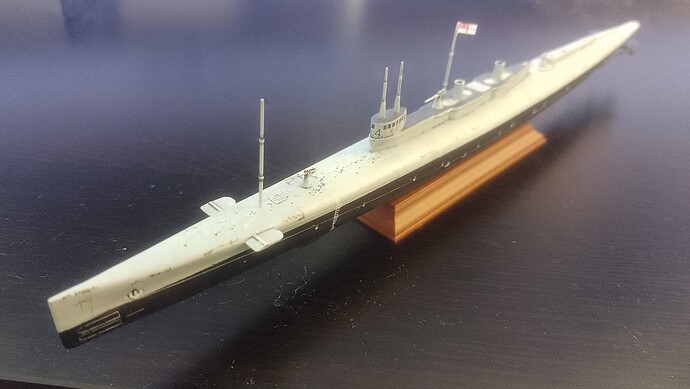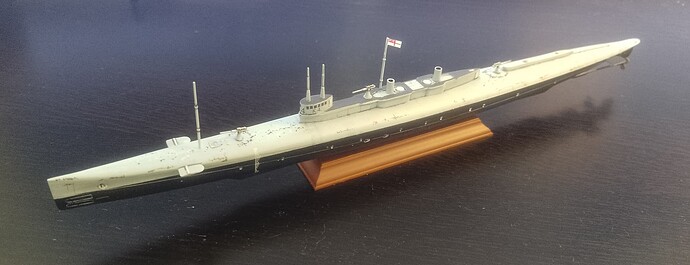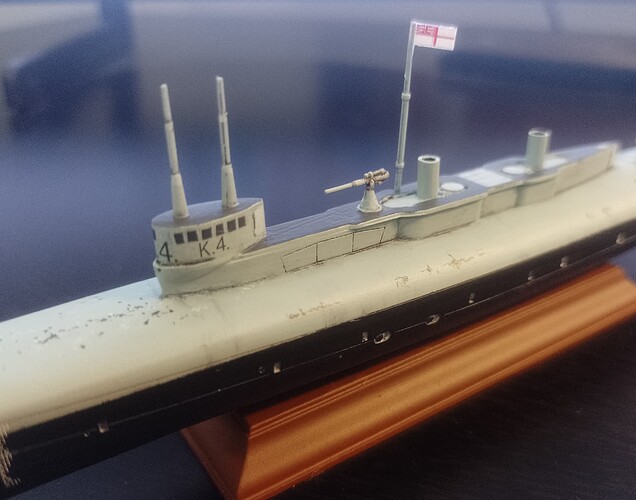So a quick effort fromy side, the 1/350 K-4 from the hideous/beautifull british K-Class from Micro Mir. Out of the box, few PE, no railing, no rigging, brush painted (yes). Just to clear the slipway. The kit is basic, needs a bit love and better screws, the PE solution offered by MM is not a solution at all.
The steam powered Killer boats?
Yep. Crazy idea over a hundred years ago.
“Killer” (or “Kalamity”) is what they were for their crews (who called themselves the “Suicide Club”), rather than the enemy… (c.f. “The Battle of May Island”)
Cheers,
M
Designed to be able to keep up with the battlefleet. that they could achieve on the surface, everything else about them was a disaster. I built one a few years back, as they were so unusual and so awful, from the MM kit, which whilst it looked to be quite accurate, but it was a bit of a beast. It is nice to see another one of these oddballs built.
Cheers, ![]() Si
Si
I read up on that this morning, that was crazy.
Wikipedia has this to say about the Kalamity class.
The horror stories:
The high temperatures in the boiler room were problematical; this was to some extent alleviated by installing bigger fans. Steaming at speed tended to push the bow into the water, making the already poor sea-keeping worse. To fix this a bulbous swan bow was added, which also incorporated a ‘quick blowing’ ballast tank to improve handling. Nevertheless, there were still problems with seaworthiness, such as that in a heavy storm, sea water could enter the boat through the short twin funnels and put the boiler fires out. The boats suffered numerous accidents, largely caused by their poor manoeuvrability when operating with the surface fleet, including:
- K13 sank on 19 January 1917 during sea trials when an intake failed to close whilst diving and her engine room flooded. She was eventually salvaged and recommissioned as K22 in March 1917.[6]
- K1 collided with K4 off the Danish coast on 18 November 1917 and was scuttled to avoid capture.
- Two boats were lost in an incident known as the Battle of May Island on 31 January 1918. The cruiser HMS Fearless collided with the head of a line of submarines, K17, which sank in about 8 minutes, whilst other submarines behind her all turned to avoid her. K4 was struck by K6 which almost cut her in half and was then struck by K7 before she finally sank with all her crew. At the same time K22 (the recommissioned K13) and K14 collided although both survived. In just 75 minutes, two submarines had been sunk, three badly damaged and 105 crew killed.
- K5 was lost for unknown reasons during a mock battle in the Bay of Biscay on 20 January 1921. Nothing further was heard of her following a signal that she was diving, but wreckage was recovered later that day. It was concluded that she exceeded her safe maximum depth.
- K15 sank at her mooring in Portsmouth on 25 June 1921. This was caused by hydraulic oil expanding in the hot weather and contracting overnight as the temperature dropped and the consequent loss of pressure causing diving vents to open. The boat flooded through open hatches as it submerged. Prior to this in May of that year the boat had survived taking water into her funnel uptakes which had doused the furnaces and caused her to sink stern first to the bottom. In that case quick action on part of her captain and crew had prevented loss of life.
K16 and K12 were both trapped on the bottom of Gareloch; their crews were luckier than that of K13 in that after several hours submerged they managed to claw their way back to the surface.
K3 held the unofficial record for maximum diving depth (266 feet [81 m]) following an uncontrolled descent to the bottom of the Pentland Firth. The ship managed to surface without further difficulty despite spending an unrecorded period below ‘crush depth.’
K4 ran aground on Walney Island in January 1917 and remained stranded there for some time.





